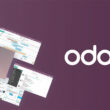Imagine a toolbox. A shiny, red one, brimming with various tools. Each one serves a unique purpose, right? But what if you reach for your trusty wrench—let’s call it Angular—and find it’s not quite gripping like it used to? Time for a quick dive into the toolbox to explore Angular alternatives!
We’re on a tech adventure to sift through the latest open-source JavaScript libraries and front-end technologies that can spruce up your web projects.
Why settle for a one-size-fits-all, when the digital world is your oyster, bursting with options like ReactJS and Vue.js?
By the end of this read, you’ll be ready to zip through the web development cosmos armed with know-how on SPA architecture and client-side frameworks.
No dilly-dallying around; we’re cutting to the chase, illuminating the paths less trodden in web development.
Expect a vista of modern component-based frameworks and tools that can redefine what you expect from a website’s under-the-hood magic. Buckle up; we’re about to embark on a thrilling code ride!
Angular alternatives
| Angular Alternative | Year Released | Key Features | Learning Curve |
|---|---|---|---|
| React | 2013 | Declarative, component-based, large ecosystem | Moderate to Steep |
| Vue.js | 2014 | Easy to integrate, MVVM, single-file components | Moderate |
| Ember.js | 2011 | Convention over configuration, full-featured | Steep |
| Aurelia | 2015 | Modern, conventions-based, extensible | Moderate |
| Backbone.js | 2010 | Minimalist, MVP, RESTful JSON interface | Easy to Moderate |
| Svelte | 2016 | Compiler, no virtual DOM, reactive | Moderate |
| Preact | 2015 | Lightweight (3KB), similar to React | Easy to Moderate |
| Mithril | 2013 | Small (9KB gzipped), fast, routing and XHR | Moderate |
| Stencil | 2017 | Web Components, TypeScript, lazy-loading | Moderate |
| Polymer | 2015 | Use Web Components, Polymer library | Moderate to Steep |
| Riot.js | 2013 | Custom tags, concise syntax | Easy to Moderate |
| Hyperapp | 2016 | 1 KB, state management & Virtual DOM | Easy |
| Inferno | 2016 | High-performance, similar to React | Moderate |
| Lit | 2019 | Simple, lightweight, Web Components | Easy to Moderate |
| Cycle.js | 2014 | Functional and reactive programming | Steep |
| Knockout | 2010 | MVVM, two-way data binding | Moderate |
| Moon | 2017 | Small, fast, purely reactive | Easy to Moderate |
| Dojo | 2018 (Dojo 2+) | Modern, TypeScript, enterprise-focused | Moderate to Steep |
| Alpine.js | 2020 | Small footprint, similar to Vue.js & React | Easy |
| Solid | 2019 | Reactive, fine-grained reactivity system | Moderate |
React
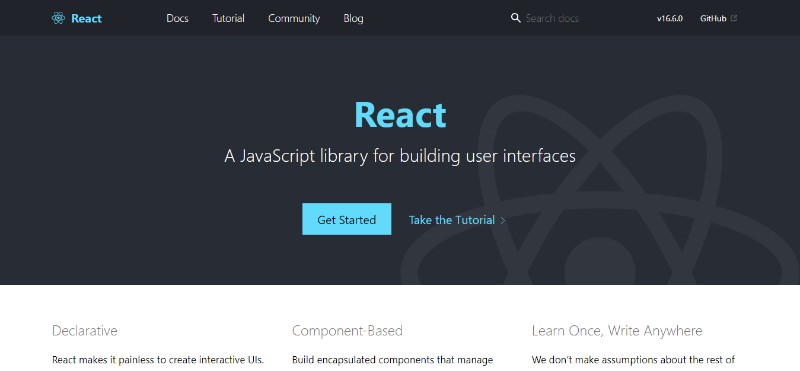
Capturing the hearts of developers with its declarative and component-based approach, React isn’t just a library—it’s a revolution in crafting seamless user interfaces. Born at Facebook, it’s all about building large-scale applications with data that changes over time.
Best Features:
- JSX for mixing markup with logic
- Virtual DOM for efficient updates
- Strong community support
What we like about it: The Virtual DOM is ace. It’s like having a backstage pass, letting you update changes in the blink of an eye, making sure the audience only sees the smooth performance on stage.
Vue.js
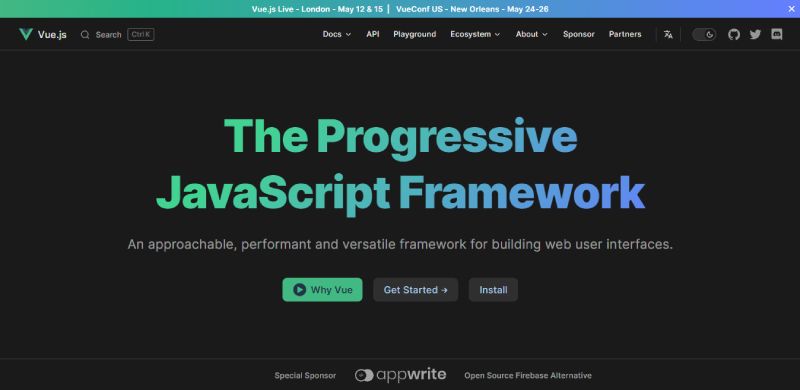
Vue.js is like that new artist who hits the perfect note between ease of understanding and flexibility. Its gentle learning curve and progressive framework let you sprinkle Vue magic into your projects as much or as little as you like.
Best Features:
- Reactive data binding
- Component-based structure
- Lightweight and versatile
What we like about it: The simplicity, for real. Even with basic HTML and JavaScript chops, you can rock a full-fledged Vue.js project. It’s like Vue has that special sauce that makes even simple dishes taste complex.
Ember.js
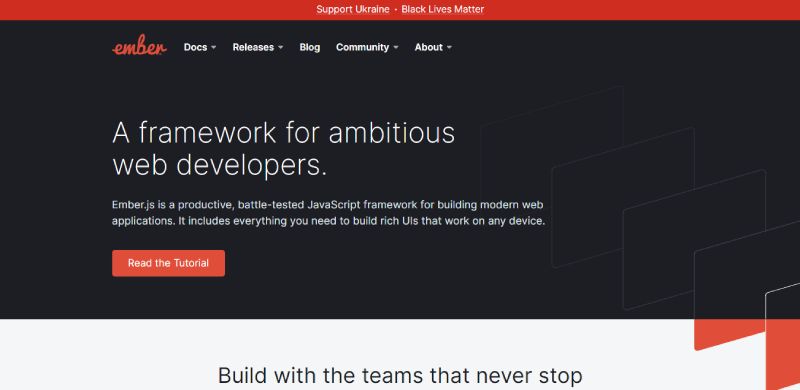
Ember.js strides in like a seasoned conductor of enterprise symphonies. It brings order to the chaos of web app creation with strong conventions and a full development stack straight out of the box.
Best Features:
- Routing as a first-class feature
- Conventional configuration
- Ambitious web applications
What we like about it: Convention wins the crown here. With a robust set of rules and best practices, Ember makes sure every member of the orchestra follows the same score.
Aurelia

Aurelia waltzes to the tune of web standards with nary a step missed. It’s all about clean coding, where your creativity isn’t hampered by the framework’s own footprint. Unobtrusive, it’s like the framework dresses in a tuxedo but insists you take the spotlight.
Best Features:
- Standards-based
- Extensible and testable
- Two-way databinding
What we like about it: The sheer elegance of how it handles extensibility. You wanna extend a component, a custom element, or maybe an attribute? Aurelia says, “Go right ahead!”
Backbone.js
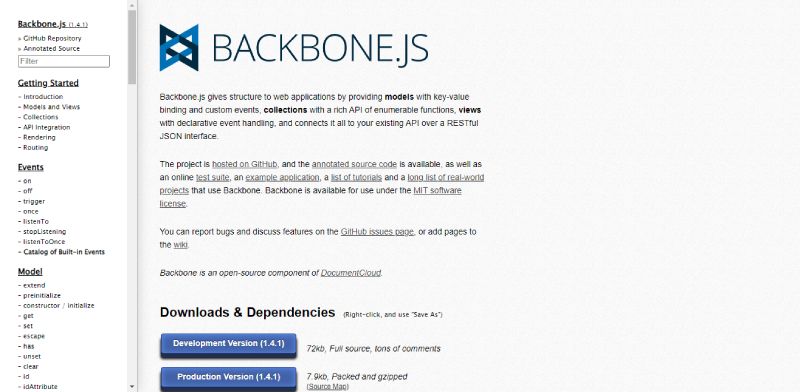
Taking a minimal approach, Backbone.js strolls in, offering the bare bones needed to put together briskly efficient web apps. Here’s to keeping things simple and making structure out of your JavaScript web creations.
Best Features:
- Lightweight MVC structure
- RESTful JSON interface
- Straightforward integration
What we like about it: That it’s straightforward with no frills. Backbone doesn’t overcomplicate what doesn’t need to be, making it a hit for straightforward projects.
Svelte
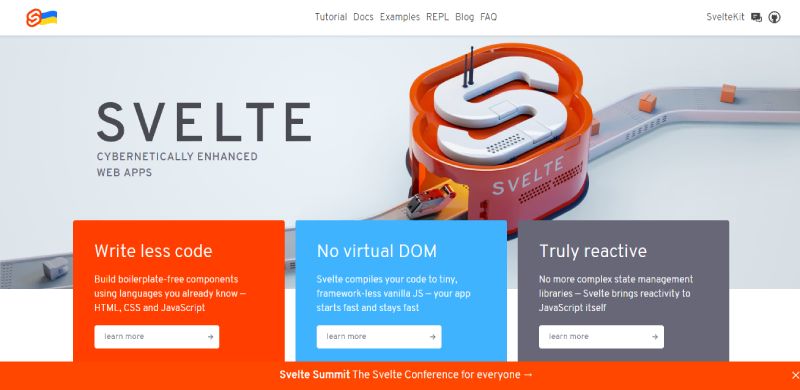
Svelte turns the spotlight on the compile step, ensuring that the app you ship out the door is all about the raw performance without an overbearing framework to slow it down. It’s innovative, taking that load off your browser’s shoulders.
Best Features:
- Minimal runtime
- Compile-time magic
- Reactive without the virtual DOM
What we like about it: Compiled JavaScript that feels like it’s been on a diet. No fluff, just the essentials, which means your users get a snappier experience without undue weight.
Preact
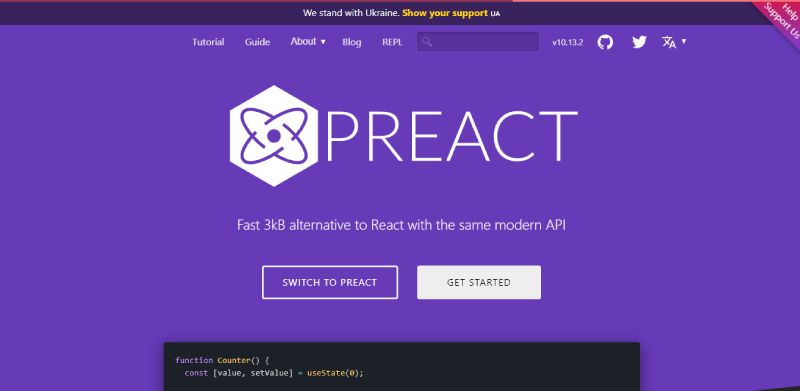
Think of Preact as React’s kid sibling: smaller, faster, and with just as much nerve. It steps in when performance is paramount, and size matters—sticking to the core notions of React but with a footprint that’s barely there.
Best Features:
- Tiny size (~3kb)
- Compatibility with React
- High performance
What we like about it: The size—it’s minuscule! Packing all that punch in 3kb means you’re zipping past the load times with ease.
Mithril
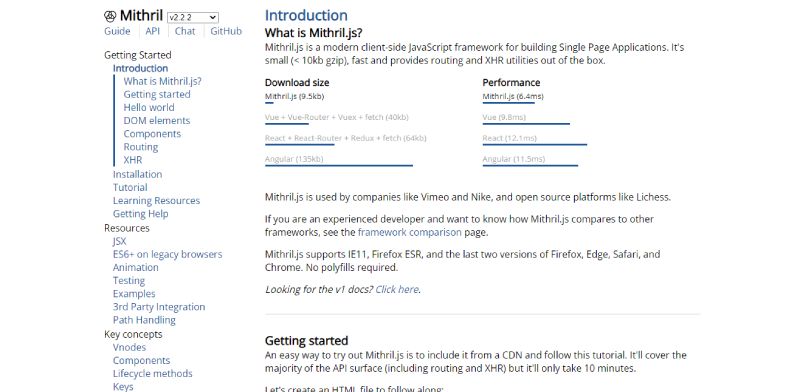
Mithril dashes in—a modern-day minimalist. It’s all about rendering fast and providing out-of-the-box routing and XHR capabilities. Designed with speed in mind, it delivers a swift developing experience without the need for loads of boilerplate code.
Best Features:
- Compact API
- Routing and componentization
- Batteries included
What we like about it: It’s like a Swiss Army Knife of frameworks: there’s no need for additional tools when you’ve got the basics this solidly covered.
Stencil
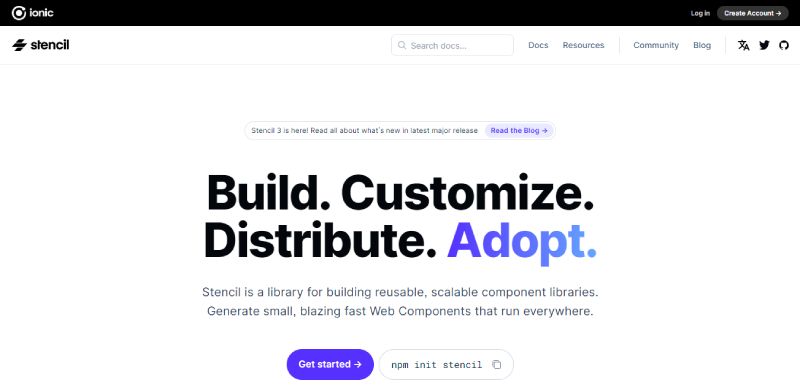
Enter Stencil, the web component compiler that lets you build reusable, scalable components. Stencil doesn’t shy away from bolstering your application while offering a future-proofed foundation compatible with any framework—or none at all.
Best Features:
- Web components
- Lazy-loading
- Stencil Store for state management
What we like about it: The focus on future-proof web components. Build once, use everywhere, through the wild and ever-changing web development landscapes.
Polymer
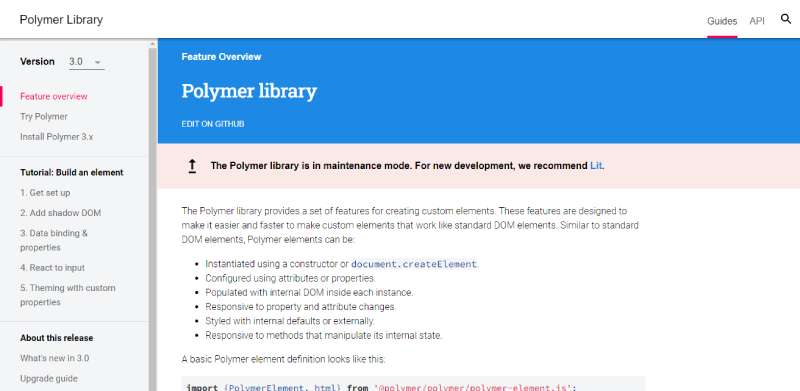
Polymer steps onto the stage with a bouquet of reusable components at its core. It’s the library designed for all who believe that the web can be more—a powerful advocate for web components before they were cool.
Best Features:
- Web components pioneer
- Interoperable components
- Material Design components
What we like about it: Its lot is cast with web components, and it shows. You get an army of elements ready to serve your web crafting needs.
Riot.js
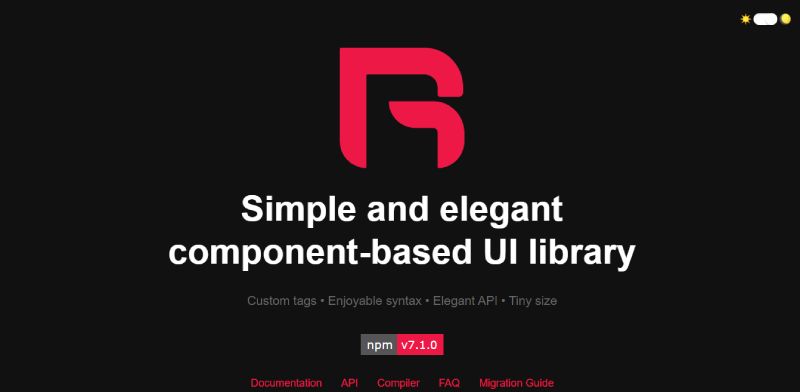
Unassuming in its essence, Riot.js is the unobtrusive framework for the poets of code. It offers a lean and mean approach to modern web applications, focusing on simplicity and providing just enough structure to get your app singing without the bloat.
Best Features:
- Elegant syntax
- Custom tags
- Tiny footprint
What we like about it: Custom tags that let you express your app’s functionality like you’re crafting a haiku. It’s coding, simplified.
Hyperapp
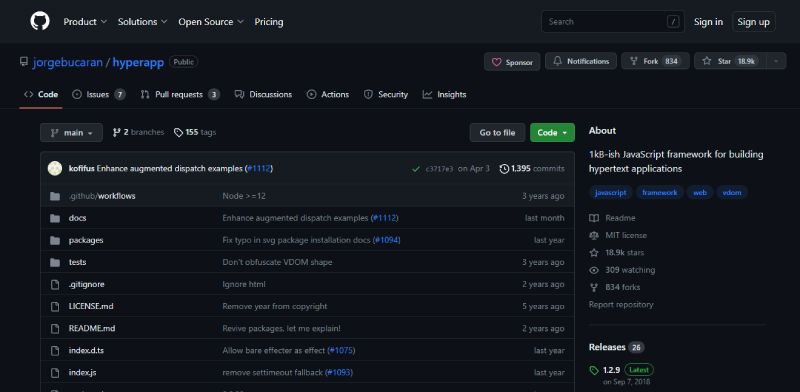
Hyperapp zips in with a magical proposition: great power with zero side-effects. A tiny framework for building web interfaces, it’s perfect for folks looking to create something out of nothing without the burden of hefty libraries.
Best Features:
- One KB in size
- Elm-inspired architecture
- Out-of-the-box state management
What we like about it: The compactness! Hyperapp delivers all that you need to build interactive apps without the extra fluff.
Inferno
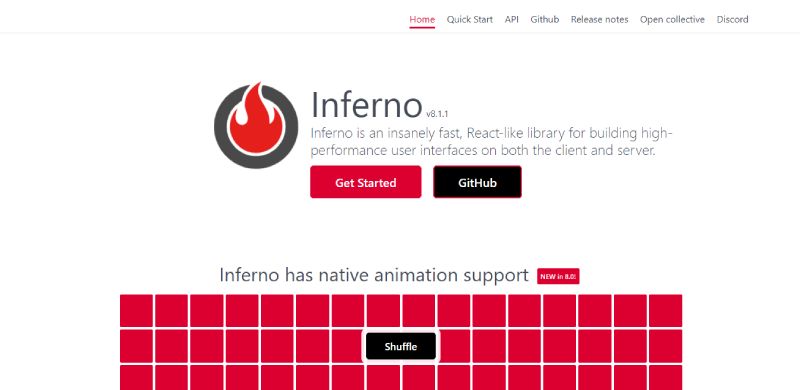
A speed demon among frameworks, Inferno blazes through operations with unparalleled rapidity. If you’re gunning for high performance above all else, Inferno’s incredible rendering speeds have got you covered.
Best Features:
- Fastest React-like library
- Real DOM diffing
- Supports old and new browsers
What we like about it: Speed, speed, and did I say speed? Inferno doesn’t horse around when it comes to delivering quick render times.
Lit
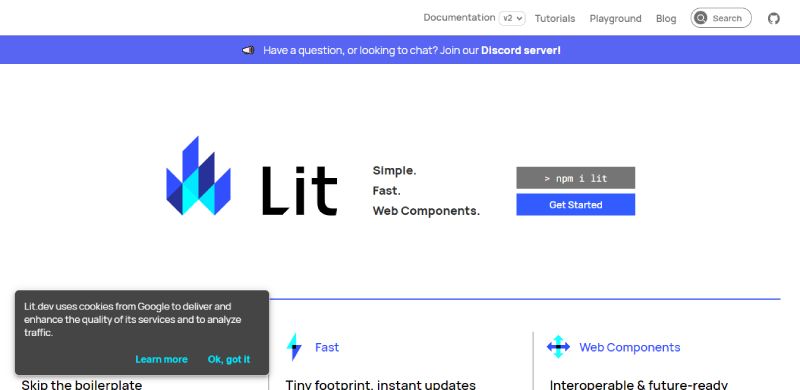
Here comes Lit, the ultra-light library for constructing speedy, expressive web components with a modern touch. It’s the spiritual successor to LitElement and lit-html—svelte and elegant with a great developer experience baked in.
Best Features:
- Lightweight
- Reactive
- Template literals
What we like about it: The sheer sleekness of it all. With Lit, building responsive web components feels more like writing poetry than code.
Cycle.js
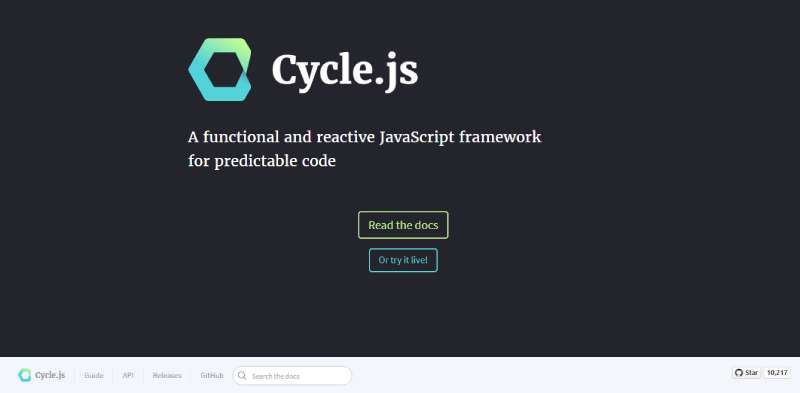
Cycle.js pedals into view, introducing a different approach to understanding user interactions and logic in applications. It’s reactive, it’s functional, and it wants you to think about your app as a series of data streams.
Best Features:
- Functional and reactive
- Drivers to interact with the outside world
- Stream-centric design
What we like about it: The stream-based architecture; it’s a refreshing take that treats user actions and data as a continuous flow.
Knockout

Knockout sits at the table with its focus on declarative bindings and automatic UI updates. It’s a venerable framework that keeps showing us building sophisticated dynamic interfaces can be straightforward and hassle-free.
Best Features:
- Declarative bindings
- Dependency tracking
- Templating
What we like about it: The simplicity of syncing your data to your UI—a gentle breeze blowing through your code.
Moon
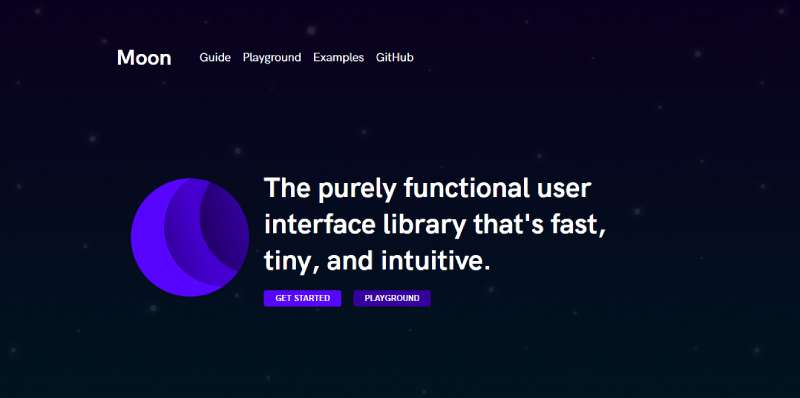
With a glow akin to its lunar namesake, Moon is for those who seek simplicity and speed in their coding odyssey. It promises a blazing-fast experience without the need for virtual DOM excess.
Best Features:
- Small size
- Fast performance
- Intuitive API
What we like about it: How it manages to be so nimble. Moon’s gentle on resources, yet quick on its feet, making it ideal for projects where speed and size matter a bunch.
Dojo
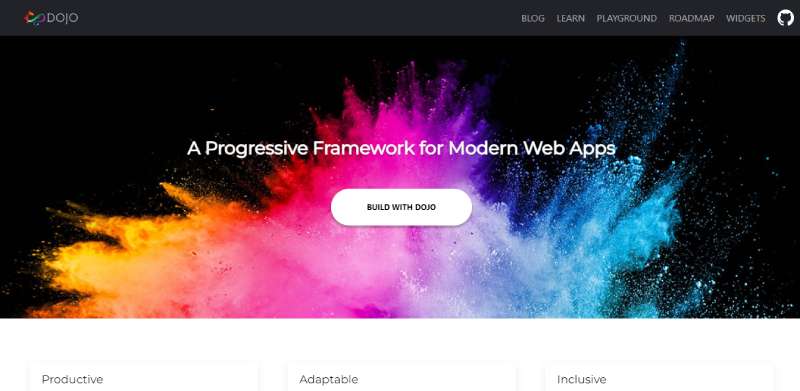
Charting its own course through the ever-changing seas of web development, Dojo offers elegant tools and a modern, reactive framework to build web applications that stand the test of time.
Best Features:
- Comprehensive widget library
- ECMAScript support
- Enterprise-level capabilities
What we like about it: Its battle-tested resilience. Dojo’s been in the game for a long time, evolving without losing its dependability.
Alpine.js
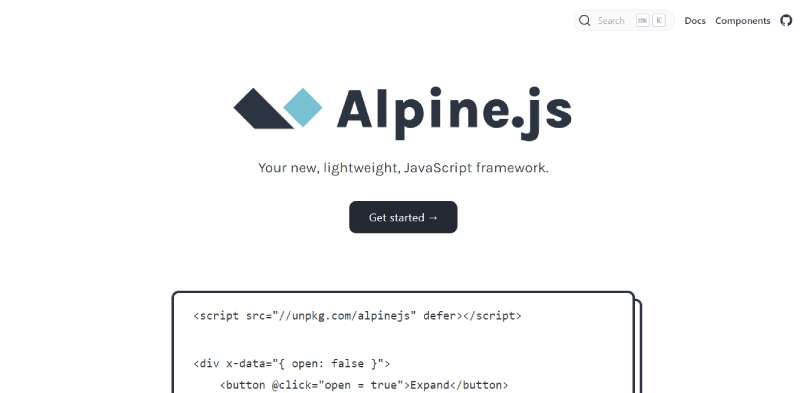
Alpine.js arrives with a flourish, embracing the spirit of minimalism while empowering you with a reactive framework as light as a feather. It’s about sprinkling interactivity naturally within your markup, almost like whispering secrets to your HTML.
Best Features:
- Directives in HTML
- Reactive and declarative
- Lightweight footprint
What we like about it: The no-nonsense approach. Alpine is dead simple to use—you might even solve half your problems with a pinch of Alpine magic.
Solid

Solid stands tall with no virtual DOM in sight, delivering reactivity and fine-grained change detection straight to your front door. It’s all about building UIs with predictability and performance in mind.
Best Features:
- Fine-grained reactivity
- No virtual DOM
- Template literals
What we like about it: The reactivity—it’s like Solid knows what you need before even you do, ready to update your app with the precision of a maestro’s baton.
FAQ on Angular alternatives
What distinguishes React and Vue.js as Angular alternatives?
They both offer a sleek, intuitive take on front-end development. React’s got a heftier community, courtesy of Facebook. Vue.js? It’s the new, flexible kid on the block, small in size but mighty in its progressive framework capabilities.
How does Ember.js compare to Angular in terms of convention and configuration?
Ember.js is like the meticulous organizer in the JavaScript MVC line-up. It’s all about convention over configuration, whereas Angular offers more flexibility but requires you to specify more of your app’s particulars.
Can Svelte be considered a viable replacement for Angular?
Absolutely. Svelte brings something fresh to the table, stepping away from the norm. Think less code, more direct, with a compiler that does the heavy lifting for you, turning your templates into lean, mean JavaScript machines.
Is Backbone.js still relevant as an Angular alternative?
Totally. Backbone.js slims down the experience. It’s pretty lightweight and gives you the basics—models, views, collections, and events—all wrapped up in simplicity.
Does Polymer offer advantages as a modern framework compared to Angular?
Polymer fishes out those reusable components and throws them into the mix. It’s all about those web components, making it a solid pick for creating extendable, highly encapsulated apps.
Is switching to Aurelia a good move for Angular developers?
Now, Aurelia’s a charmer. It’s all-in for clean code, minimal framework interference, so if you’re into that, Aurelia could be your ticket to a smoother development experience.
With Angular, should I consider Node.js as an alternative?
Node.js? It’s more of a back-end pal. This runtime environment works hand-in-hand with Angular rather than as its substitute. It’s about expanding your horizons, integrating the server side with client magic.
How does Knockout.js fare in comparison to Angular?
Knockout.js keeps things straightforward with a MVVM pattern. It’s smaller, yes, but punches above its weight class with a sharp focus on data-binding.
Would using a less known alternative like Aurelia affect performance?
Framework Performance isn’t always about being in the spotlight. Aurelia’s performance can swing toe-to-toe with the big names; it’s efficient and gets along well with modern browsers, so no worries there.
Can TypeScript be used with these Angular alternatives?
TypeScript isn’t just for Angular; it’s an all-rounder. Cross-platform frameworks embrace it, offering a typed superset of JavaScript that you can buddy up with a variety of frameworks for an enhanced coding experience.
Ending thoughts
We’ve danced through the landscape of Angular alternatives, waltzing past frameworks that each, in their own right, twirl to the beat of modern web crafting. It’s not just about swapping out tools; it’s about finding that sweet spot where open-source JavaScript libraries or client-side frameworks sync to your project’s rhythm.
So there we go,
- The mighty, the popular, and the mighty popular like ReactJS.
- The understated elegance of Vue.js.
- The organized beats of Ember.js.
- Svelte, stripping back to the sleek, essential steps.
- Polymer and its keen eye for reusability.
The melody of web development never stops; it evolves, grows, and shifts. There’s a harmony in finding the framework that resonates with your workflow, elevates your project, and just… feels right. Tailor your tech wardrobe with a pick from this diverse array, and watch your digital designs strut down the runway, ready to dazzle and perform.
If you liked this article about Angular alternatives, you should check out this article about PHP alternatives.
There are also similar articles discussing Ruby alternatives, Redux alternatives, Express alternatives, and Spring alternatives.
And let’s not forget about articles on Flask alternatives, TypeScript alternatives, Laravel alternatives, and Python alternatives.
- SQL in Action: What is SQL Used For? - April 30, 2024
- Professional Video Editing with Apps Like Kinemaster - April 29, 2024
- Benefits of Working with a Professional Web Development Company For Your Website - April 29, 2024




